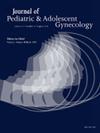32. 青少年继发性闭经的子宫内膜增生
IF 1.7
4区 医学
Q3 OBSTETRICS & GYNECOLOGY
引用次数: 0
摘要
背景子宫内膜癌是全球最常见的妇科恶性肿瘤。发病率正在增加,特别是在肥胖的年轻女性中,但在青少年中有可能被遗漏,因为表现特征,如月经异常出血,是常见的。本病例描述了一名被发现患有子宫内膜增生的青少年,并探讨了这种情况的危险因素和管理。病例一名18岁女性,有4年的慢性盆腔疼痛史。继发性闭经9个月,体重指数(BMI)升高(BMI 53kg/m2)。既往脊柱MRI示子宫内膜条纹增厚[图1],再次行盆腔造影,显示子宫内膜增厚(19mm)。宫腔镜和子宫内膜活检证实子宫内膜增生,无异型性,子宫内膜腔内放置子宫内膜系统(IUS)。7个月后复查宫腔镜和子宫内膜活检显示子宫内膜增生消退,但12个月复查宫腔镜和子宫内膜活检再次发现子宫内膜增生无异型性。(图二)。15个月复查宫腔镜显示更典型的子宫内膜薄腔,子宫内膜活检仅获得少量样本,但未见异型性报告。计划在6个月内再次进行宫腔镜检查和活检,目前正在等待减肥手术。本病例报告描述了一例罕见的青少年确诊子宫内膜增生无异型性。考虑到其癌前病变的可能性,子宫内膜增生对于青少年来说是一个重要的诊断,特别是对于那些有BMI升高等危险因素的青少年。超声扫描虽然不能诊断青春期多囊卵巢综合征,但在考虑鉴别诊断和子宫内膜评估方面仍具有重要作用。超声子宫内膜评估使风险分层的青少年谁将受益于子宫内膜活检,以确定子宫内膜增生。本文章由计算机程序翻译,如有差异,请以英文原文为准。
32. Endometrial hyperplasia in an adolescent with secondary amenorrhoea
Background
Endometrial cancer is the most common gynaecological malignancy globally. The incidence is increasing, particularly in younger women with obesity but has the potential to be missed in adolescents as the presenting features, such as abnormal menstrual bleeding, are common. This case describes an adolescent who was found to have endometrial hyperplasia and explores the risk factors and management of this condition.
Case
An 18-year-old female was referred to adolescent gynaecology with a 4 year history of chronic pelvic pain. A 9 month history of secondary amenorrhea with raised body mass index (BMI) (BMI 53kg/m2) was noted. Previous spinal MRI imaging showed suggestion of a thickened endometrial stripe [Fig1] so repeat pelvic imaging was arranged which reported endometrial thickening (19mm). Hysteroscopy and endometrial biopsy confirmed endometrial hyperplasia without atypia, and a Mirena Intrauterine System (IUS) was placed in the endometrial cavity. Repeat hysteroscopy and endometrial biopsy 7 months later showed resolution of endometrial hyperplasia but subsequent hysteroscopy and endometrial biopsy at 12 months again found endometrial hyperplasia without atypia. [Fig2]. At 15 months repeat hysteroscopy showed a more typical appearing cavity with thin endometrim, endometrial biopsy with only yielded a scanty sample but with no atypia reported. A repeat hysteroscopy and biopsy in another 6 months is planned and they are currently awaiting bariatric surgery.
Comments
This case report describes a rare case of confirmed endometrial hyperplasia without atypia in an adolescent. Given its premalignant potential, endometrial hyperplasia is an important diagnosis to consider in adolescents, particularly in those presenting with risk factors such as raised BMI. Ultrasound scan whilst not diagnostic for polycystic ovarian syndrome in adolescence still has an important role in considering differential diagnoses and for endometrial assessment. Ultrasonographic endometrial assessment enables risk-stratifying for adolescents who would benefit from endometrial biopsy to identify endometrial hyperplasia.
求助全文
通过发布文献求助,成功后即可免费获取论文全文。
去求助
来源期刊
CiteScore
3.90
自引率
11.10%
发文量
251
审稿时长
57 days
期刊介绍:
Journal of Pediatric and Adolescent Gynecology includes all aspects of clinical and basic science research in pediatric and adolescent gynecology. The Journal draws on expertise from a variety of disciplines including pediatrics, obstetrics and gynecology, reproduction and gynecology, reproductive and pediatric endocrinology, genetics, and molecular biology.
The Journal of Pediatric and Adolescent Gynecology features original studies, review articles, book and literature reviews, letters to the editor, and communications in brief. It is an essential resource for the libraries of OB/GYN specialists, as well as pediatricians and primary care physicians.

 求助内容:
求助内容: 应助结果提醒方式:
应助结果提醒方式:


